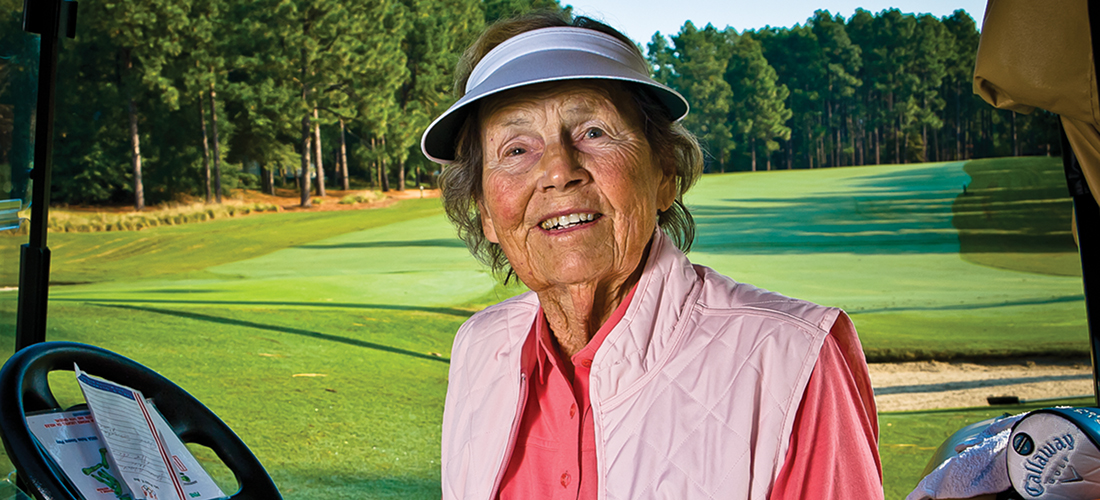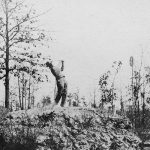
The grace of a smooth takeaway
By Bill Fields
Peggy Kirk Bell loved to go fast whether piloting a plane, driving a car or riding a motorcycle, and to be sure there weren’t many females negotiating Midland Road on a Yamaha 100 in the early 1970s. She had plenty of pop on her golf shots as well, for many years teeing off from the tips on her beloved Pine Needles Lodge and Golf Club and holding her own with the men in her group, whether it was her husband, Warren “Bullet” Bell, or, later on, her sons-in-law Pat McGowan, a PGA Tour member, and Kelly Miller, a scratch amateur.
Because she was a skilled golfer, the clubhead speed came at the right time, of course, her movements as coordinated as holiday decorations at the White House. Bell’s smooth swing — in addition to her textbook grip and setup and full turn — fit the classic ideal: Without good timing, power isn’t worth a flip.
“I found it more of a challenge than any sport I’d tried,” Bell wrote of taking up the game at 17 in a 2001 memoir, The Gift of Golf: My Life With a Wonderful Game, with PineStraw contributor Lee Pace. “You simply couldn’t haul off and slam the ball like you would a softball.” When no less than Tommy Armour stresses the importance of a good waggle, and teaches it to you, as he did for Bell, that has a way of helping your rhythm.
Forty years ago, the Bells allowed our Pinecrest High School golf team to hit balls, yellow ones, with a “PROPERTY OF WARREN BELL” stamp, after school on the far end of the practice range — as many as we wanted, until we got tired or it got dark. Mrs. Bell usually was busy teaching a paying student, but occasionally this major championship-winning amateur, LPGA charter member and renowned instructor would check out the actions of me and my fellow Patriots, who possessed more enthusiasm than talent.
“Slow it down a little,” Bell might say, the accent of her native Ohio softened by decades of life in North Carolina, the cadence of her words echoing a nice takeaway. She was big on the basics — making sure the handle of the club rested in the fingers, not the palm, of the top hand; that your posture was good; that your feet aligned parallel to the ball like the railroad tracks that went through town. She was a firm believer that a building can’t be very tall without a strong foundation, and after one of those gratis drop-bys from Mrs. Bell, you inevitably played a bit better.
When Peggy Kirk Bell died at age 95 on Nov. 23, the day before Thanksgiving, many people could reach deep into a well of memories of this champion player who evolved into a wonderful teacher of the game. Both a local institution around the Sandhills — you knew her as the nice lady in the Lincoln convertible even if you knew nothing about golf — and a national treasure, for Bell the game wasn’t just a living but a passion. She shared that deep affection each time she gave a lesson or told a story about someone she had known in her full life, which included most of the finest players over several eras, celebrities and ordinary folks who savored a shot hit far and sure no matter if such an occasion were the rule or a happy exception.
“She had great patience, a lot of stamina, and she understood that the spirit of the game is a social experience,” Michael Hebron, a PGA Master Professional who taught with Bell at Pine Needles’ innovative “Golfaris,” told Golf World upon her passing. “People were comfortable coming back because they knew they were going to have fun.”
The best teachers are generous souls as Bell was, the largesse contrasting with her love of a bargain, which made her a favorite of the Taco Bell drive-thru. That the U.S. Women’s Open was contested three times (1996, 2001, 2007) at Pine Needles was a fitting tribute to how the Bell family had nurtured the Donald Ross gem through good times and bad. Less remembered is how Peggy and Bullet, at a financial loss, staged the 1972 Titleholders Championship, the women’s major she had won as an amateur in 1949 and that had not been played since 1966. Sandra Palmer won the event’s first and only final playing at Pine Needles, by a whopping 10 strokes over Judy Rankin and Mickey Wright.
Bell was active in the Fellowship of Christian Athletes — she is pictured at a meeting of the Pinecrest chapter in one of my yearbooks — and her family gave area clergy playing privileges. The same courtesy was extended to Golf World editors when the magazine was based in Southern Pines, even if their life’s work wasn’t quite so serious. Local law enforcement officers got the wave, too, if the tee sheet wasn’t filled up. My dad, a policeman and deputy in Moore County, had a Pine Needles courtesy card in his wallet when he passed away in 1980.
In addition to winning the Titleholders at Augusta (Ga.) Country Club, which was more or less the Masters for women, Bell won the North and South Women’s Amateur and Ohio Women’s Amateur as well in 1949, the third straight year she had won her state title. By then she had played on the golf team at Rollins College, where she graduated with an education degree in 1943, and won the International Four-Ball in 1947 with the legendary Babe Didrikson Zaharias, a close friend and frequent golf partner. Zaharias was godmother to the Bells’ first child, Bonnie, born in 1954. The last round of golf Zaharias played in 1956 before dying of cancer at 45 was with Bell.
Turning pro after playing on the United States Curtis Cup team in 1950, the year that the LPGA was founded, Bell, then Peggy Kirk, got her LPGA charter member card on April 15, 1951, signed by Zaharias, the fledgling circuit’s president. Bell played full-time for a couple of years, augmenting meager prize money with plenty of exhibitions, flying herself to tournaments in a Cessna purchased for $8,000. She split her time between competing and instructing — it was definitely trial by error in her initial lesson tee efforts — after marrying Bullet, and they began operating Pine Needles in 1953.
With the addition of two more children, Peggy Ann in 1958, and Kirk in 1962, she traveled less and developed into one of the game’s finest teachers. Bell’s specialty was her unique week long golf schools for women at Pine Needles called the Golfaris, group lessons that combined first-rate instruction in a homey atmosphere but were foremost a testament to her energy and expertise.
Bell got many plaudits for her enduring contributions, from being inducted in seven halls of fame to receiving some of golf’s top distinctions. None was greater than the 1990 Bob Jones Award, the USGA’s top honor, for distinguished sportsmanship in golf. Near the end of Bell’s life, there had been lobbying in some quarters for her induction into the World Golf Hall of Fame.
Whether that happens or not, Bell’s legacy includes too many smiles to count, brighter than any trophy, from golfers for whom she made a difficult game just a little easier. No small feat, that, by a good sport and so much more. PS





